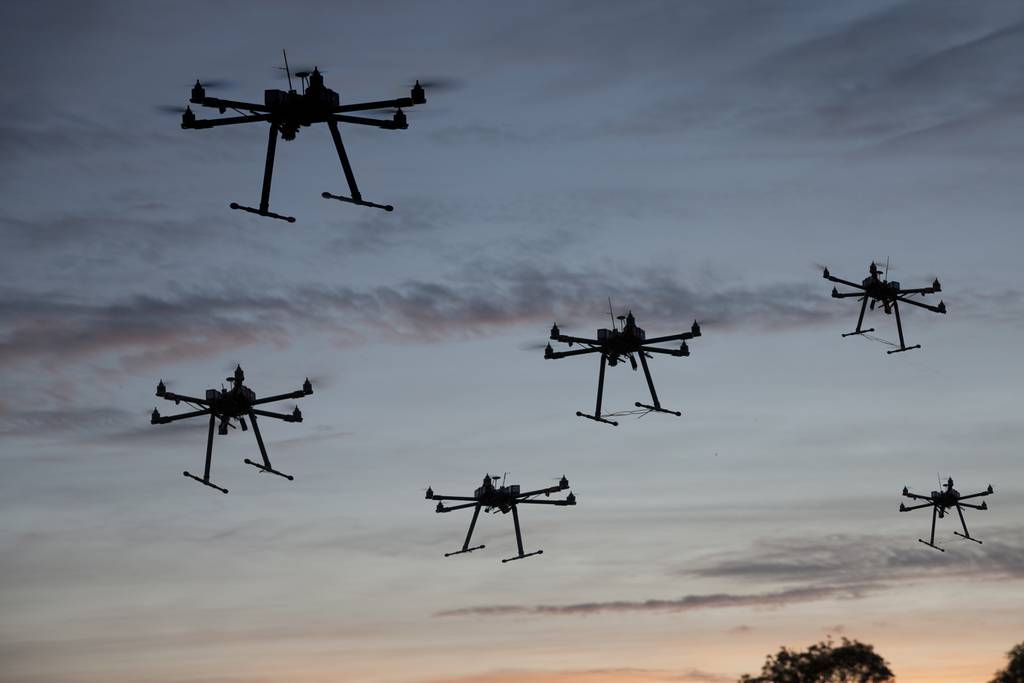
This week, Deputy Defense Secretary Kathleen Hicks announced a new and important initiative, named Replicator, which is designed to “field attritable autonomous systems at scale of multiple thousands, in multiple domains, within the next 18-to-24 months.” The initiative is specifically designed to help counter China’s growing military power. Some of those versed in the Pentagon acquisition bureaucracy took to social media following the announcement to express their doubts about the initiative due to the size, scale and timeline. Their concerns are rooted in bureaucratic tradition and an aversion to change — and they couldn’t be more wrong.
This is not the first time in the past few decades that the Pentagon has embarked on an aggressive acquisition initiative to meet a strategic threat. Last month, I had the privilege to meet some of the engineers and workers who assembled and built my mine-resistant, ambush-protected vehicle, or MRAP, that I was issued during the Iraq War in 2008. These vehicles were designed and rapidly manufactured and deployed to the war zones to counter the No. 1 killer of U.S. troops in Iraq and Afghanistan: improvised explosive devices, commonly referred to as roadside bombs, which the Pentagon had declared a weapon of strategic influence.
The team building the MRAPs worked 120-hour weeks during the height of production to meet the demand. If they had delayed even two weeks, I and another dozen soldiers I know personally would not be here today. There are thousands of others who can say the same.
The fielding of MRAPs and electronic warfare equipment was reactionary, as it happened in response to an ongoing conflict. In the case of Replicator, the initiative is proactive and meant to mitigate a growing gap in military capability in order to help deter conflict. This tells us a few things.
The Pentagon as an institution is a creature of habit where change and challenges to established bureaucratic processes can be met by open hostility. I watched this happen when then-Deputy Defense Secretary Ash Carter created the Strategic Capabilities Office. This initiative would not be necessary in the time frame in which it was announced unless the threat of conflict or the need to reestablish deterrence was acute and exceeded the time frame of normal acquisition processes. To put it plainly, the adversary gets a say about when things happen, and China’s timeline for the deployment of military capabilities that will tip the balance of power and erode deterrence is far shorter than our acquisition cycle.
Former Defense Secretary Donald Rumsfeld was lampooned for his response to a question posed by a U.S. service member overseas about the need for up-armored vehicles. Rumsfeld said: “You go to war with the Army you have, not the Army you want.” In this case, the Pentagon appears to be trying to get ahead of growing tensions and capability gaps by rapidly fielding systems needed to restore or reinforce deterrence.
This bold initiative is one that should be embraced by each of the armed services. It is a chance to reset the playing field and the clock in the hopes of deterring conflict, which have been eroded over the past decade and a half.
The Russian invasion and subsequent war in Ukraine has shown what autonomous and unmanned systems can do in combat. Much of it has been improvised, and yet produced strategic effects, such as the unmanned naval surface drones that have been used by Ukraine to attack ships in Russia’s Black Sea Fleet headquarters in Sevastopol as well as the Kerch Bridge that serves as the main logistics and resupply corridor for Russian forces in Crimea. That is in addition to all of the UAVs used against targets in both Ukraine and Russia. These technologies will continue to evolve and improve over time.
The United States cannot allow the gap in military capabilities and technologies compared to China to grow and expect strategic deterrence to hold. A significant and rapid investment in attritable unmanned autonomous systems is a good start, and the initiative announced by Deputy Defense Secretary Hicks should be embraced and supported by executive departments and agencies as well as by Capitol Hill.
This initiative is not a panacea for the growing military threat posed by China, but it wasn’t designed to be. More will be needed in order to mitigate the threat and deter conflict, but this is a good place to start. The Department of Defense has risen to the occasion many times in the past. This is another opportunity to do the same and hopefully prevent future conflict in doing so.
Alex Plitsas is a nonresident senior fellow with the N7 Initiative, a partnership between the Atlantic Council think tank and the Jeffrey M. Talpins Foundation. He is also a principal and industry director for aerospace and defense as well as high-tech electronics at Providence Consulting Group.
- SEO Powered Content & PR Distribution. Get Amplified Today.
- PlatoData.Network Vertical Generative Ai. Empower Yourself. Access Here.
- PlatoAiStream. Web3 Intelligence. Knowledge Amplified. Access Here.
- PlatoESG. Automotive / EVs, Carbon, CleanTech, Energy, Environment, Solar, Waste Management. Access Here.
- PlatoHealth. Biotech and Clinical Trials Intelligence. Access Here.
- ChartPrime. Elevate your Trading Game with ChartPrime. Access Here.
- BlockOffsets. Modernizing Environmental Offset Ownership. Access Here.
- Source: https://www.defensenews.com/opinion/2023/08/31/the-pentagons-replicator-effort-to-counter-china-is-the-right-call/



